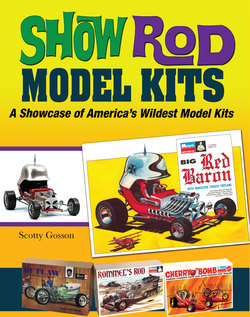Читать книгу Show Rod Model Kits - Scotty Gosson - Страница 8
На сайте Литреса книга снята с продажи.
ОглавлениеINTRODUCTION
Scaled-Down Show Rods for a Scaled-Down Economy
The dive-in-and-see-what-happens ethos of the beatnik gearheads who designed and built the 1:1 show rods seems to have infected everyone associated with them and the resulting comedy is hereby delivered for your amusement. May it educate, entertain, and inspire you . . .
It was invaluable training: Mowing lawns and washing cars to earn a weekly allowance garnered us several intrinsic life lessons, including time and money management. Other than tricking out our bicycles, our mechanical creative outlets were mostly limited to building models from kits, financed with said allowance.
Who could have guessed that we’d somehow survive countless hours of spray paint and glue huffing only to face an economy decades later demanding the same skill set we developed to finagle $2 model kits with 20 hours of hard labor? Sweet irony, reflected in our ultimate model of choice: the show rod.
In hindsight, we can see (with corrective lenses) that our childhood preferences were informed by a media in cahoots with manufacturers and marketing departments. But we can’t deny how deeply the hook was set. Wild show rod imagery continues to haunt the subconscious until it ultimately can’t be repressed any longer. At that point, we must lay out a show rod chassis design on the garage floor and begin flinging sparks, start collecting the show rod models of our dreams, or both. There’s no other way to continue on without going incurably insane. That’s just how it is. Alas, economics dictate which path to pursue, and many of us find ourselves on the short end of the dollar. So, which way to the hobby shop?
Luckily, we now live in an era of aging hoarders, reproduction entrepreneurs, and instant worldwide communication with both camps. The models are out there, and this book will hopefully save you some time and money in your quest to sniff them out. An informed hunter is more likely to succeed than not. And the education is actually a pretty fun ride! If there’s anything as wacky and amusing as a full-on show rod, it has to be the stories behind how they came to be chosen and modeled. Those adventures even carry over to the manufacturing and marketing of the model kits themselves.
Model cars continue to transport torches from one generation to the next. And that torch power propels them across all borders. Custom car historian Rik Hoving and eight-year-old son Abe get down to the details in the Netherlands on Ed Roth’s Revell Outlaw kit. (Esther de Charon Photo, Courtesy Rik Hoving)
Alas, history has not been kind to us researchers, as little documentation remains regarding full-scale show rods and models of the time. Manufacturer catalogs seem to have vanished with the years, leaving model kit release dates to be repeatedly shuffled to suit the agenda du jour. Many of the principals involved have passed on. And most of the survivors readily admit to memory loss. Regardless, I sleuthed on, with a little help from my friends . . . and this endeavor required enough of them to fill an entire Acknowledgments page!
MANUFACTURER CATALOGS SEEM TO HAVE
VANISHED
WITH THE YEARS
Another wrench in the works is the confounding definition of a “show rod.” In 1:1 scale, show rods are generally defined as completely scratch-built cars, intended for indoor car show display. “Scratch-built” has its own ambiguity, but is recognized in the chassis fabrication arena as referencing a totally custom-built frame, chassis, and body. There is plenty of gray area to go around, as some of the wildest show rods (Chuck Miller’s Fire Truck and Red Baron and the Bell and Trantham’s Outhouse, for example) sat on standard T-bucket chassis (which were non-stock yet still aftermarket production-line creations, often in kit form, further confusing the issue). In fact, Fire Truck even employed a production-style body (although it was scratch-built. Where do these loopholes end?).
So while show rod parameters are somewhat elastic, publishing space limitations dictate sticking to some semblance of guidelines. For the purposes of this book, the publisher and I have agreed to abide by the rules of the model kit collecting domain, where the show rod term generally pertains to scale copies of actual show rods or original concepts that could be actual show rods. Caveat: I am prone to throwing rule books out of windows. You’ve been warned.
